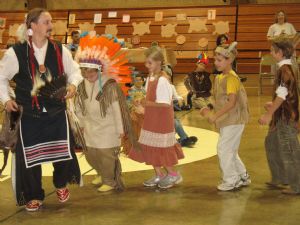 Another Stereotype of the Month entry:
Another Stereotype of the Month entry:
 Another Stereotype of the Month entry:
Another Stereotype of the Month entry:
Acting out history: St. Patrick students portray Indians, colonists to learn about cooperation
By VALERIE WELLS — H&R Staff Writer
DECATUR — Wearing a headdress of multicolored paper "feathers," Ian Mc-Keown portrayed Chief Sun Slayer at St. Patrick School's Thanksgiving feast Thursday.
Fifth-grade students are finishing a study of the early settlement of the New World, with a focus on the cooperation between the American Indians and the colonists. Students dressed as Indians, and the girls in the class elected Ian, 10, to portray the chief.
"That's how it's really done," said their teacher, Kathy Litz. "The women choose the chief."
The children made their costumes, mostly out of construction paper, and chose an Indian-style name for themselves. They also dubbed their "tribe" the Powhatan Pee Wees, because they've been studying the Powhatan tribe and because the students are small, they decided they should tack "pee wees" on the end.
"I started this (dinner) when I came here about 10 years ago," Litz said. "It started out very small, then we invited the fourth grade and they dressed as Pilgrims. Fifth-graders all want to be Indians. Then a couple of years ago, we invited the third grade and they said, 'We'll just be the turkeys.'"
Fifth grade is "the American history year," Litz said, and students have been using the Internet to take a virtual tour on the Mayflower. Parents pitch in to cook and serve the meal.
"We just couldn't do anything without our parents," said Marybeth Earnhart, the fourth-grade teacher.
Fourth-graders, following in the footsteps of their older schoolmates, elected Cody Jarrett to portray William Bradford, governor of the Plymouth colony.
The day began with a prayer service, led by Earnhart and some of the students. Earnhart said the service was modeled on the first Thanksgiving in that they thanked God for a bountiful harvest and friends.
One thing Litz emphasizes in her class is that when the European settlers traded wampum (a prized string of beads) for land, the American Indians thought the Europeans understood that the land was not theirs alone, but for both peoples to share. The fifth-graders make maps to symbolize the land, and the fourth-graders make wampum to give them in exchange for the land.
"If you ask a fifth-grader, they'd better know that," Litz said. "We're giving them the land, but it was given to all of us by God to share."
Rob's reply
Educator Debbie Reese deconstructs this classroom activity in Those Thanksgiving Lesson Plans. Her main points:
Note: As is often the case, the above photo isn't of the class in question, but it might as well be.
Related links
Indian wannabes and imitators
The big chief
"Funny" Indian names
Indians owned the United States
|
. . . |

|
All material © copyright its original owners, except where noted.
Original text and pictures © copyright 2007 by Robert Schmidt.
Copyrighted material is posted under the Fair Use provision of the Copyright Act,
which allows copying for nonprofit educational uses including criticism and commentary.
Comments sent to the publisher become the property of Blue Corn Comics
and may be used in other postings without permission.